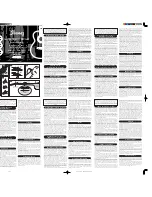
4
Power supply/AC power adaptor
• Do not connect the instrument to an electrical outlet
using a multiple-connector. Doing so can result in
lower sound quality, or possibly cause overheating
in the outlet.
• When removing the electric plug from the instru
-
ment or an outlet, always hold the plug itself and
not the cord. Pulling by the cord can damage it.
•
Do not use if the power adaptor plug or cord is damaged.
• Remove the electric plug from the outlet when the
instrument is not to be used for extended periods of
time, or during electrical storms.
• Do not cover or wrap the power adaptor with a cloth
or blanket. Heat buildup during use can cause fire
or deform the case. Use in a well ventilated area.
• Remove the batteries from the instrument when us
-
ing the power adaptor. When batteries are installed,
the power source automatically switches to the AC
power adaptor when connected. Leaving batteries
in the instrument can cause leakage.
Assembly
• Please refer to the “Attaching the Frame” section on
page 9 of this manual for instructions on attaching
the frame. Not following the instructions may result
in injury or damage.
• Make sure both frame fixing screws are fastened
securely after attaching the frame. Loose screws
can cause rattling resulting in noise while playing.
• Please take care not to pinch your fingers or hands
in movable parts.
Location
• Do not expose to direct sunlight (in a car during the
day), high temperatures such as near a stove, or
extremely low temperatures, and do not expose to
vibrations or dust to prevent damage to the internal
components or panel disfiguration.
• Do not use close to electronics such as speakers,
TV, and radio. The instrument’s electronic circuits
may cause noise in the TV or radio.
CAUTION
Always follow the basic precautions listed below to avoid the possibility of physical injury to
you or others, or damage to the instrument or other property. These precautions include, but
are not limited to, the following:
Yamaha cannot be held responsible for damage caused by improper use or modifications to the instrument.
Always turn the power off when the instrument is not in use.
Make sure to discard used batteries according to local regulations.
• Do not place the instrument in an unstable position
where it might accidentally fall over.
• Before moving the instrument, remove all con
-
nected cables, to prevent damage to the cables or
injury to anyone who might trip over them.
Connections
• Before connecting the instrument to other electronic
components, turn off the power for all components.
Before turning the power on or off for all compo
-
nents, set all volume levels to minimum.
• Never return the signal from the outputs (PHONES/
LINE OUT) directly or via an external device to the
AUX IN jack. Doing so can cause a feedback loop
that damage the instrument.
Handling caution
• Never hold the instrument close to your face when
adjusting or replacing strings. A string may unex-
pectedly break damaging your eyes.
• If you cut the strings when replacing, do so after
sufficiently loosening the pegs. Sudden loss of
string tension may damage the neck and the re-
bounding strings may cause serious injury.
• Replace strings one by one to prevent the saddle
and pickup sensor from moving. A sensor is in-
stalled beneath the saddle to pickup string vibration.
If the saddle falls out make sure the sensor position
has not changed. Reattach the saddle positioning
the lower end of the saddle beneath the first string.
• If cleaning is required, wipe with a soft cloth. Do
not use thinners, solvents, cleaning fluids, or wipes
soaked with chemicals. Also. Do not place vinyl or
plastic products on the instrument. Doing so can
cause discoloration/deterioration.
• Do not rest your weight on, or place heavy objects
on the instrument, and do not use excessive force
on the buttons, switches or connectors.
• Do not use the instrument or headphones/earphones
for a long period of time at a high or uncomfort-
able volume level, since this can cause permanent
hearing loss. If you experience any hearing loss or
ringing in the ears, consult a physician.






















